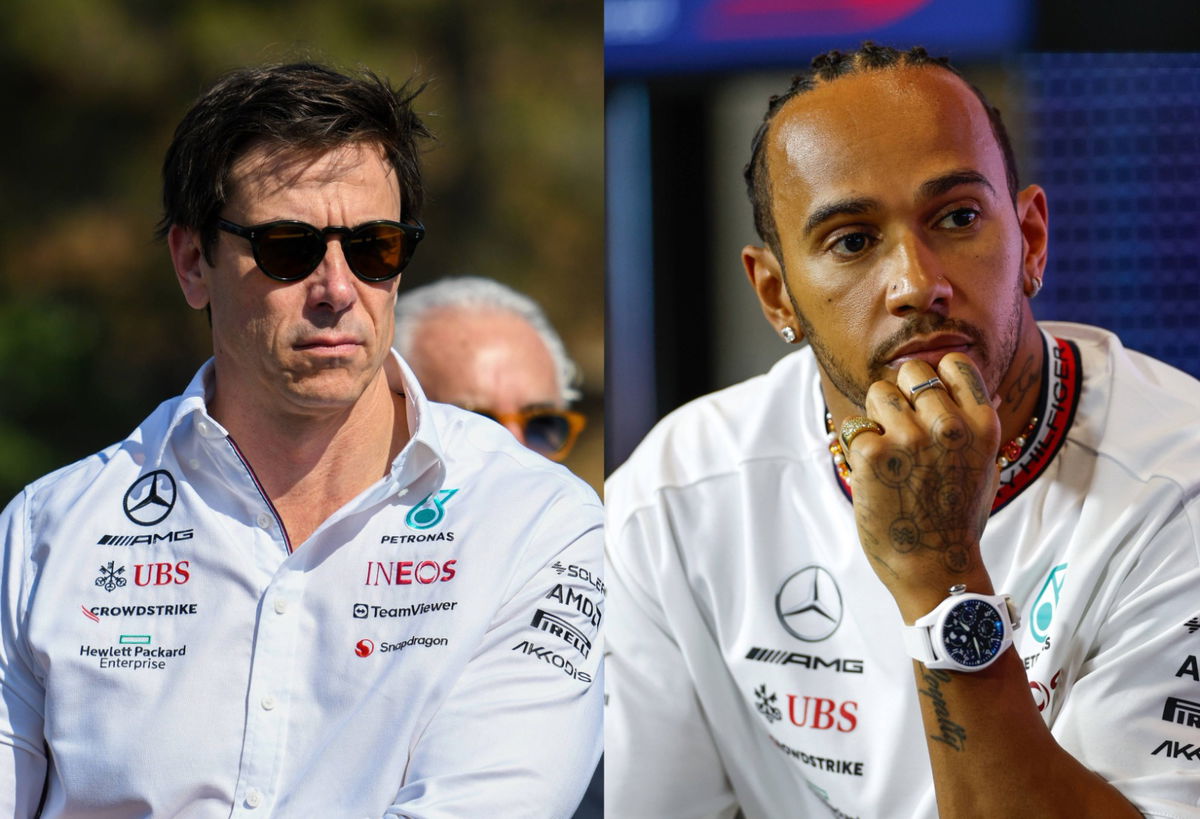
Imago
Image Credits: Imago | L: Toto Wolff, R: Lewis Hamilton

Imago
Image Credits: Imago | L: Toto Wolff, R: Lewis Hamilton
As the neon-lit dusk of Las Vegas inches closer to welcoming the roar of Formula 1 engines, the spectacle promises an adrenaline surge reminiscent of the city’s own heartbeat. It’s been four decades since the engines’ symphony echoed through the streets of Sin City, and the return of the Las Vegas Grand Prix is poised to set pulses racing. Lewis Hamilton, with a pedigree of seven world championships to his name, is no stranger to the lure of the American dream, having expressed an infectious enthusiasm for the Las Vegas circuit. The fervor was palpable during a pre-event party that witnessed F1 aficionados swarm the city in anticipation. The British racing icon, alongside an assembly of F1 stalwarts, painted a picture of unbridled excitement about what could be an “incredible” race.
Watch What’s Trending Now!
Yet, beneath the glitz, there lies a perturbing undercurrent for the Mercedes team, which threatens to dim the luster of Hamilton’s Vegas dream. On the flip side of this optimism, the Mercedes camp faces an introspective period after a grueling Sao Paulo Grand Prix that left Team Principal Toto Wolff with a sour taste. Mercedes’ W14, the silver arrow that once consistently pierced the heart of victory, seems to have lost its edge. Wolff’s scathing critique labeled the vehicle “miserable” and unworthy of a win, a sharp contrast to the gleaming Vegas lights on the horizon.
ADVERTISEMENT
Article continues below this ad
A streak of silver in the shadows: Mercedes wrestles with performance puzzles
The disparity between the car’s potential and actual performance has been stark, manifesting in a “miserable” run at the Brazilian event, according to Wolff. The results were stark; Hamilton’s race witnessed a plummet from an impressive P3 at the start to a disappointing P8 at the flag, while George Russell, his teammate, couldn’t even see the chequered flag, retiring on lap 59. Wolff’s frustration was unmistakable as he conveyed a sentiment that no amount of sugar-coating could conceal: the W14 was a far cry from its predecessors, bordering on undrivable at times.

Imago
15th September 2023 Marina Bay Street Circuit, Singapore 2023 Formula 1 Singapore Airlines Singapore Grand Prix Free Practice Day Mercedes team principal Toto Wolff arrives at the track PUBLICATIONxNOTxINxUK ActionPlus12553370 StephenxBlackberry
Mercedes’ season has been rife with peaks and troughs, leaving much to be analyzed. Wolff’s admission of the car’s knife-edge temperament casts a long shadow over their Las Vegas aspirations. Hamilton, despite the excitement for the upcoming race, must contend with a machine that, in Wolff’s blunt assessment, simply “doesn’t deserve a win.” The looming Las Vegas Grand Prix now represents more than just a race; it’s a proving ground, an opportunity for redemption, and perhaps a chance for Mercedes to shuffle the deck and come out on top in the city of chance.
ADVERTISEMENT
Article continues below this ad
Read More: Lewis Hamilton Laughed at His Own Misery as Toto Wolff & Co. Left the 7X Champ Helpless in Brazil
The Brazilian Grand Prix of 2023 threw a curveball that the Mercedes team is still trying to catch. It was a weekend that left Team Principal Toto Wolff and his crew scratching their heads as they watched their Silver Arrows struggle on the Interlagos circuit—a stark contrast to their podium finish just a week prior. This only begs the question to be answered: what now?
ADVERTISEMENT
Article continues below this ad
Toto Wolff & Co. in deep reflection post Brazilian GP
At the heart of the issue was the car’s shaky rear end, leading to a dance of imbalance and tire wear that no driver would want to lead. The overly cautious approach to ride height—stemming from a recent disqualification over plank wear—seems to have backfired, leaving the team with more questions than answers. The mechanical gremlins hiding in the machinery evaded the team’s diagnostics, contributing to Lewis Hamilton trailing a minute beyond the checkered flag waved for Max Verstappen.

Imago
Toto Wolff, Team Principal, Mercedes AMG Petronas F1, Freies Training 2, FP2, Grosser Preis von Italien, Motorsport, Formel 1, Saison 2023, 01.09.2023 ITA, Formel 1, Autodromo Nazionale Monza, 01.09.2023 Monza *** Toto Wolff, Team Principal, Mercedes AMG Petronas F1, Free Practice 2, FP2, Italian Grand Prix, Motorsport, Formula 1, 2023 season, 01 09 2023 ITA, Formula 1, Autodromo Nazionale Monza, 01 09 2023 Monza Copyright: xEibner-Pressefoto/Grafx EP_AGF
Despite the setback, there’s no hint of defeat in Wolff’s resolve. With eyes already on the prize for 2024, the talk is of a major overhaul. A new car design is on the drawing board, and the intention is clear: Mercedes aims to bounce back, sharper and more competitive. Andrew Shovlin, the Trackside Engineering Director, echoed this sentiment, acknowledging the limitations they faced at Interlagos and the urgency to rectify these for the final races of the season.
The silver lining, if it can be called that, is the upgrade introduced back in Austin, which despite the Brazilian bungle, is seen as a beacon for the 2024 design. The W14 has flaws, but it’s these very imperfections that are shaping the team’s resolve and strategy going forward. George Russell’s optimism serves as a testament to the team’s spirit, viewing Brazil as a hiccup rather than a prognosis of the car’s overall strength.
Watch This Story | Sir Lewis Hamilton Undergoes a Name Change in Mother’s Honor
Mercedes’ response to their Brazilian blues is a cocktail of introspection and innovation. The acknowledgment of their issues is the first step, and the commitment to an extensive revamp for the next season is their leap towards reclaiming their spot at the pinnacle of F1 racing. It’s a tale of a team faced with adversity and choosing to forge ahead, turning their trials into a roadmap for future triumphs.
ADVERTISEMENT
ADVERTISEMENT
ADVERTISEMENT
ADVERTISEMENT

